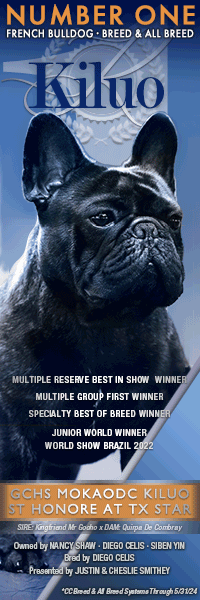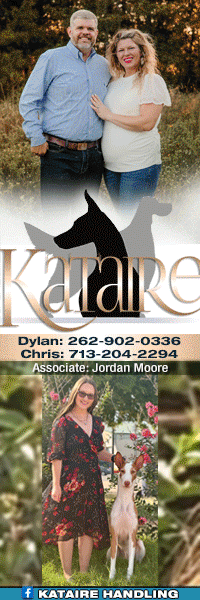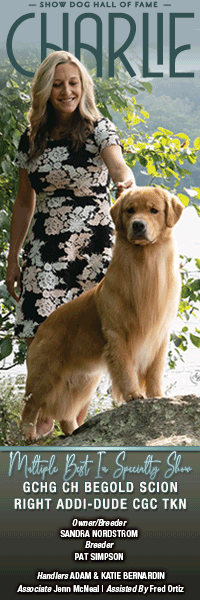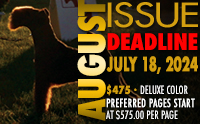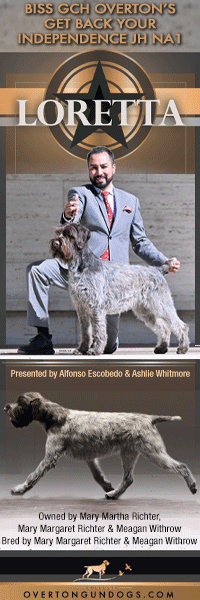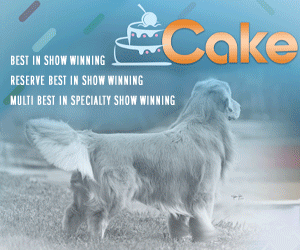Outcrossing – If, When, and Why?
Click here to read the complete article
By William Given
Inbreeding and linebreeding facilitate our ability to establish our own strain within our chosen breed. These breeding systems afford us the opportunity to more easily fix the characteristics we desire most within our strain. They are, however, not the only methods of breeding available to us.
Outcrossing is defined as the mating of two dogs that are totally unrelated. There are some breeders who would define outcrossing as the breeding of two dogs with no common ancestors in a four generation pedigree. That definition seems reasonable because the genes affecting the resulting progeny are concentrated in the first four generations. Outcrossing does offer its advantages, but any breeder who is mulling over the idea of an outcross breeding should do so only for a specified purpose.
There are some very good reasons why an experienced breeder would choose to make an outcross. The first is to bring into their line a characteristic that is absent. And, akin to the first reason, to build on a strength and make a good trait – an exceptional one. The second is to mitigate any faults that are provoked by homozygous recessive genes. And third, outcrossing is absolutely necessary when a breeding program shows a loss of vigor (sometimes referred to as inbreeding depression) as demonstrated by a lack of disease resistance or infertility.
The Results of Outcrossing
Perhaps more often than not, the puppies of a first-generation outcross of two excellent show dogs display many outstanding traits of their parents. That is why, when a good number of the first-generation puppies from outcross matings are doing so well in the show ring, their breeders and others who have noted this, rush to conduct similar breedings.
It is after the first generation of an outcross breeding that a breeder stands to lose everything gained from a successful outcross unless he or she breeds back into his or her established line. To be successful as a breeder, one must seek to produce puppies which are genetically dominant for all of the qualities required by the breed’s standard. The closer a breeder gets to the ideal, the more uniform in type the puppies and dogs the breeder produces will be. When a breeder uses more distantly related dogs or dogs with no common ancestors in their breeding program, he or she must expect less uniformity in the offspring.
Any virtues that are obtained through outcrossing cannot possibly be considered a part of the genetic constitution of a breeder’s strain until those traits have been fixed within the line through inbreeding or linebreeding. A breeder should consider outcrossing, quite simply, as a means to an end. Contrary to the belief of some breeders, a successful outcross cannot and will not cure all imperfections in a bloodline in one generation.
The inevitable tragedy is the young of the succeeding generations of outcross breeding will be a comparably heterogeneous lot, displaying what could easily be an absolute lack of uniformity. This will not only prevent the breeder from maintaining proper type, but will subject their line and the breed to an increase in differing types in size and structure.
These breeders do a disservice to their breed, and in as much as they are the ones primarily responsible for the increased differentiation in type, open up themselves for damage to their reputation. Uniformity and predictability in the quality of the puppies produced is the goal and the trademark of a good breeder.
When To Make an Outcross
If you were to ask me, “After how many successive generations of inbreeding or linebreeding should I make an outcross?” I would respond by asking you, “What will be the six winning lottery numbers for Saturday’s drawing?”
There is an old wives’ tale that says it is not safe to inbreed or linebreed more than three generations without the introduction of an outcross. Virtually every colleague that I queried on this matter has had an anecdote to share with me about when the “golden words of wisdom” were shared with them and by whom. When the fallacy originated that it is not safe to inbreed or linebreed more than three generations without an outcross nobody seems to know, but it is just not a valid premise. Breeders who believe that an outcross needs be made at some finite point as, for example, the previously mentioned third generation are giving credit to the old wives’ tale, and it is one to which some breeders seem to be particularly devoted.
There is also a popular belief that, “It is just plain good to bring in fresh blood to a line every now and then.” Nothing could be further from the truth. It is inbreeding and linebreeding that (if correctly utilized) facilitate the elimination of recessive factors that produce faults, and provide for the purification within a line or strain. It is the close-up breeding on the blood of one or more superior dogs that allow breeders to rapidly minimize the influence of the more faulty forebears and contribute to the establishment of distinct type.
Dangers of Continued Outcrossing
When superior results are obtained in the first generation of an outcross, many breeders think the breeding was an unprecedented success and all that needs be done thereafter is to continue such outcrossing to become a great breeder with an established type of their own, producing a high average of very exceptional puppies. They could not be more mistaken, since the exact opposite is surely to occur.
As a general rule, the progeny of first-generation, outcross breedings are very often quite uniform in appearance. Many of the puppies being even more correct than the sire and dam. However, if not bred back into the original line, it is the puppies from succeeding generations of such outcrosses that can be particularly disappointing. This is because they carry so many genes for all of the characteristics in which their parents differed, that those puppies show great variation. This includes a sizeable portion of puppies of less than show and breeding quality.
I would inform some and remind others that, genetically, outcrossing and cross-breeding (Labrador Retriever to Poodle, for example) differ only by the measure of degree. Both involve the breeding of two individual dogs whose genetic composition varies so widely that there must be a significant rearrangement of genes in the offspring produced.
As breeders, we must be concerned not only with the physical conformation of the sire and dam, but also with the genes inherited from all of their more direct progenitors. It must be remembered that outcrossing is just as likely to weaken or diminish positive traits that are already fixed as to add those which were lacking and highly desired.
Reaching Out Through Outcrossing
It is my belief that, when outcrossing, to obtain a desired characteristic not present in his or her line, or to correct a fault a breeder has not been able to eliminate through linebreeding, he or she should make the outcross as close as possible. I strongly recommend an attempt to obtain the desired trait or improvement by securing the services of a stud possessing the needed characteristic, and who is also if possible in the fifth- or sixth-generation of the pedigree or even partially related closer in the line. Using this method, a breeder may save himself or herself from the need to breed several succeeding generations in order to fix the traits obtained through the outcross.
The matter of what to do after making an outcross is important. If you were fortunate, and secured the desired characteristic or corrected the fault you wanted to eliminate through the outcross, your next step is to inbreed or linebreed with careful selection so that the benefits derived from the outcrossing may be fixed in your line. If the results of your outcross were less than you had hoped for, you may be faced with the need to cull and start over, or attempt to negate the poor results through inbreeding or linebreeding.
There are a couple of reasons why some breeders obtain very positive results through outcrossing. The first is that what initially looked to be a total outcross may actually be the result of breeding two dogs that are not as unrelated as it appeared when simply looking at a three or four generation pedigree. There may be common ancestors farther back.
The second reason is due to prepotency. A successful breeder sincerely desiring to produce high quality puppies usually searches for a prepotent stud dog with an established history of siring outstanding progeny. It is generally accepted that these dogs pass on dominant genes because they are, in almost every case, the result of solid inbreeding or linebreeding. Because of this, they have the ability to impose their own characteristics over the recessive genes of the dams.
Breeding Up
A good many breeders have started with a very average bitch from a good bloodline. They then invest their time thoroughly analyzing pedigrees and their money in breeding to an outstanding sire. They keep the best pups in each litter, continue to refine their breeding practices, and become well-known as highly successful breeders.
There are also many examples of breeders going astray and producing average or inferior dogs as a result of a loss of focus on breeding to the standard. Instead of success, they achieve failure due to their desire to chase the latest fad or fancy.
The Failing of Experience
The number of novice breeders who know virtually nothing about the third- and fourth-generation ancestors in their dogs’ pedigrees is truly alarming. Far too many experienced breeders cannot even name the grandsires and granddams of the dogs they own. I wager that only a select few of the most successful breeders could complete a four-generation pedigree of just one of their dogs from memory.
It seems appropriate for me to state here and on the record that unless a breeder has a full and complete knowledge and understanding of the strengths and weaknesses of all of the dogs through at least the third generation of the pedigree (and farther back is preferable) he or she will very probably not become a good breeder, let alone ever be acknowledged as a great one. A breeder must know from where came specific traits, both desired and unwanted, if he or she expects to retain the good and eliminate the bad. This cannot be accomplished with casual breedings, whether they be inbred, linebred, and most certainly by outcrossing.
Newcomers to the sport often lack a full understanding of just what constitutes a truly good specimen of their breed. Unless they can quickly develop a special relationship with an experienced mentor, the learning process can be painfully slow. Many novice breeders begin breeding before they have acquired any real understanding of the principles of genetics or gained any experience researching pedigrees.
Experienced exhibitors and breeders far too often fail to acknowledge the importance of novices and fail to take an active role in ensuring they are a success in the show ring and in the whelping box. We must remember that they will be the ones replacing those of us in my age group (and older) who are, for a wide variety of reasons, constantly disappearing from the game.
High standards, the careful selection of good breeding stock, thorough pedigree analysis, choosing the proper system of breeding, and an honest evaluation of the puppies produced are all tools that a breeder may use to build a successful breeding program.
Short URL: http://caninechronicle.com/?p=93409
Comments are closed


